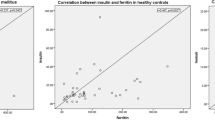Abstract
Free iron in serum has been found in several disease conditions including diabetes. In the present work, we studied the relationship between free iron, fasting blood glucose (FBG) and glycated haemoglobin (HbA1c). Study was carried out on 50 type 2 diabetes cases under poor glycemic control associated with complications, 53 type 2 diabetes cases under good glycemic control and 40 healthy controls. We estimated free iron, both ferrous (Fe+2) and ferric (Fe+3) form, protein thiols, lipid hydroperoxides, FBG, HbA1c and serum ferritin levels in serum. There was a significant increase in free iron in Fe+3 state (p <0.01), HbA1c (p<0.01), serum ferritin (p<0.01), lipid hydroperoxides (p<0.01) and significant decrease in protein thiols (<0.01) in diabetes cases under poor glycemic control compared to diabetes cases under good glycemic control and healthy controls. Free iron correlated positively with HbA1c (p<0.01). Poor glycemic control and increase in glycation of haemoglobin is contributing to the increase in free iron pool which is known to increase oxidant generation.
Similar content being viewed by others
References
Tanner LI, Lienhard GE. Localization of transferrin receptors and insulin like growth factor II receptors in vesicles from 3T3-L1 adipocytes that contain intracellular transporters. J Cell Biol 1989;108:1537–1545.
Niederau C, Berger M, Stremmel W, Strake K, Stroymeyer G, Ebert R. Hyperinsulinemia in non-cirrhotic hemochromatosis: impaired hepatic degradation. Diabetolgia 1984;26:441–444.
Fernandez-Real JM, Lopez-Bermejo A, Ricart W. Cross talk between the iron metabolism and diabetes. Diabetes 2002;51:2348–2354.
Lim SC, Vaziri DN. The effects of iron dextran on the oxidative stress in cardiovascular tissues of rats with chronic renal failure. Kidney Int 2004; 65:1802–1809.
Batey RG, Lai Chung Fong P, Shamir S, Sherlock S. A non-transferrin bound serum iron in idiopathic hemochromotosis. Dig Dis Sci 1980; 25:340–346.
Graham G, Bates GW, Rachmilewitz EA, Hershko C. Nonspecific serum iron in thalassemia:Quantitation and chemical reactivity. Am J Hematol 1979; 6:207–217.
Zager AR, Johnson MCA, Hanson YS, Wasse H. Parenteral iron formulations: a comparative toxicologic analysis and mechanism of cell injury. Am J Kidney Dis 2002; 40:90–103.
Prakash M, Upadhya S, Prabhu R. Serum non-transferrin bound iron in hemodialysis patients not receiving intravenous iron. Clin Chim Acta 2005;360:194–198.
Lim SP, Wei HY, Yu LY, Kho B. Enhanced oxidative stress in hemodialysis patients receiving intravenous iron therapy. Nephrol Dial Transplant 1999; 14:2680–2687.
Fujimoto S, Kawakami N, Ohara A,. Non-enzymatic glycation of tranasferrin: decrease of iron binding capacity and increase of oxygen radical production. Biol Pharm Bull 1995;16:396–400.
Manoj K, Chakrobarthy AS. Release of iron from hemoglobin — a possible source of free radicals in diabetes mellitus. Ind J Exp Biol 1999;37:190–192.
Wardman P, Candeias PL. Fenton centennial symposium. Radiat Res 1996;145:523–531.
Lehen-Beyel, Groot HD, Rauen U. Enhancement of iron toxicity in L929 cells by D-glucose: accelerated reduction. Biochem J 2002;368:517–526.
Harnett ME, Stratton RD, Browne RW, Rosner BA, Lanham RJ, Amstrong D. Serum markers of oxidative stress and severity of diabetic retinopathy. Diabetes Care 2000;23(2):234–240.
Ahmed N, Babael-Jadidi R, Howell SK, Beisswenger PJ, Thornalley PJ. Degradation products of proteins damaged by glycation, oxidation and nitration in clinical type 1 diabetes. Diabetlogia 2005;48(8):1590–1603.
Nilsson AU, Bassen M, Savman K, Kjellmer I. A simple and rapid method for determination of free iron in biological fluids. Free Radic Res 2002; 36:677–684.
Motchnik AP, Frei B, Ames NB. Measurement of antioxidants in human blood plasma: protein thiols In: Oxygen radicals in biological systems: Methods in Enzymology, Editor Packer L, California: Academic press, volume 234, part D, page 273–274, 1994.
Nourooz-Zadeh J. Ferrous iron oxidation in presence of xylenol orange for detection of lipid hydroperoxides in plasma In: Oxidants and antioxidants: Methods in Enzymology, Editor Packer L, California: Academic press, volume 300, page 58–62, 1999.
Nourooz-Zadeh J, Tajaddini Sarmadi J, McCarthy S, Betteridge JD, Wolff PS. Elevated levels of authentic plasma hydroperoxides in NIDDM. Diabetes 1995;44:1054–1058.
Fairbanks VF, Klee GG. Biochemical aspects of hematology. In: Tietz NW, ed. Fundamentals of clinical chemistry. 3rd ed. Philidelhia: WB Saunders; 789–824, 1987
Trinder P. Determination of blood glucose using an oxidaseperoxidase system with an non-carcinogenic chromogen. J Clin Pathol 1969 Mar; 22(2):158–161.
Klenk DC, Hermanson GT, Krohn RI, Fujimoto EK, Mallia AC, Smith PK, et al. Determination of glycosylated hemoglobin by affinity chromatography: Comparison with colorimetric and ion exchange methods and effects of common interferences. Clin Chem 1982; 28: 2088–2094.
Hider RC. Nature of non-transferrin bound iron. Eur J Clin Invest 2002;32(suppl 1):50–54.
Author information
Authors and Affiliations
Corresponding author
Rights and permissions
About this article
Cite this article
Shetty, J.K., Prakash, M. & Ibrahim, M.S. Relationship between free iron and glycated hemoglobin in uncontrolled type 2 diabetes patients associated with complications. Indian J Clin Biochem 23, 67–70 (2008). https://doi.org/10.1007/s12291-008-0016-4
Published:
Issue Date:
DOI: https://doi.org/10.1007/s12291-008-0016-4




